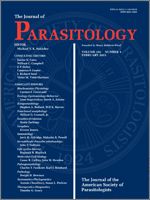In 1984, work on the parasite population and community ecology in the pulmonate snail, Helisoma anceps, was initiated in Charlie's Pond (North Carolina). Similar research on Physa gyrina was started in 1986. When study in the pond began in 1984, 8 species of larval trematodes were being shed from Hel. anceps. By far, the dominant species was Halipegus occidualis, with prevalences generally ∼60%, except during midsummer, when older snails were dying. For the other 7 trematode species being shed, prevalences were consistently less than 4%. By 2006, 18 species had been identified in Hel. anceps at one time or another. In 1986, Hal. eccentricus was discovered in P. gyrina, with a prevalence of ∼49%. Through 2006, 7 trematodes were found to be shedding cercariae from P. gyrina. Halipegus eccentricus disappeared from the pond in 1998. From March through November of 2012 and 2013, 1,292 Hel. anceps and 716 P. gyrina were collected, using collection protocols that were identical to those used from 1984 through 2006. In 2012, 5 trematode species, including Hal. occidualis, were present in Hel. anceps at one time or another. During the last part of the 2012 collecting season cercariae of just 2 species were being shed from Hel. anceps (and 1 from P. gyrina). In 2013, only cercariae of Haematoloechus longiplexus and Uvulifer ambloplitis were observed from Hel. anceps. The latter species was lost by 2014, and an echinostome was present (2.1%); a single snail was infected with Haem. longiplexus. Four species were being shed from P. gyrina, i.e., Echinoparyphium sp. (7.9%), Glypthelmins sp. (1.5%), Plagiorchis sp. (4.9%), and Posthodiplostomum sp. (7.4%). Rarefaction curves were generated for Hel. anceps shedding in 1984, 1988, 1989, 2002, 2006, and August of 2014. The data clearly indicate that species diversity was constantly declining over the 31-yr period. We did not include P. gyrina in the analysis since data for this snail species were not acquired until 1991–1992. At present, we have no definitive explanation for the decrease in diversity, although circumstantial evidence suggests that it might be related to periodic declines in water level that negatively affected the colonization and maintenance of emergent vegetation within the pond.
BioOne.org will be down briefly for maintenance on 17 December 2024 between 18:00-22:00 Pacific Time US. We apologize for any inconvenience.
How to translate text using browser tools
1 February 2015
Catastrophic Collapse of the Larval Trematode Component Community in Charlie's Pond (North Carolina)
Collin Russell,
Tina Casson,
Courtney Sump,
Kyle Luth,
Michael Zimmermann,
Nicholas Negovetich,
Gerald Esch
ACCESS THE FULL ARTICLE

Journal of Parasitology
Vol. 101 • No. 1
February 2015
Vol. 101 • No. 1
February 2015




